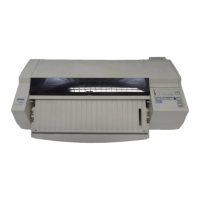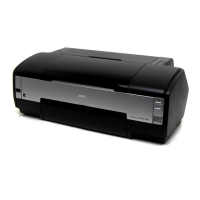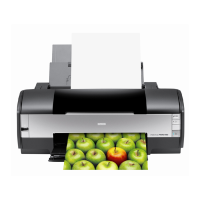Troubleshooting
The printer may exhibit different symptoms for the same problem, which makes troubleshooting
more difficult. This section, however, provides simple and effective ways to facilitate
troubleshooting.
Table 5-1. Motor Coil Resistance Test Points
Motor
Connector
Number
Test Pin
Number
Test Method
(Set Meter to Ohms. Disconnect
Motor from Main Board and Check it
with Printer Power Off.)
Meter Reading
CR Motor
(CN5)
Common pin: 5
Test pins:
1, 2, 3, 4
Place one lead on pin 5 and the other
lead on each of the 4 test pins to
check the two motor phases.
5 Ω ± 7 %
(At 25° C, 77° F)
PF Motor
(CN6)
1 and 3 /
2 and 4
Place one lead on pin 1 (pin 2) and
the other lead on pin 3 (pin 4) each of
the test pins to check the two motor
phases.
10 Ω ± 10 %
(At 25° C, 77° F)
Table 5-2. Sensor Status
Sensor Test Points Signal Level Status
HP Sensor
CN9
Pin 1 to 2
H (>2.5 V) In home position (HP)
L (GND) Away from HP
Front
PE Sensor
CN10
Pin 1 to 2
Open Paper present
Closed No paper (Paper end)
Rear
PE Sensor
CN11
Pin 1 to 2
Open Paper present
Closed No paper (Paper end)
Black Ink End
Sensor
CN12
Pin 1 to 2
Closed and
Black ink
cartridge
sensor closed
Ink present
Any other Ink end
Black Ink
Cartridge
Sensor
CN13
Pin 1 to 2
Open No black ink cartridge
Closed Black ink cartridge installed
Release
Sensor
CN14
Pin 1 to 2
Open Friction feed
Closed Tractor Feed
Disengage
Gear
Sensor
CN15
Pin 1 to 2
Open Disengage gear is on pump side
Closed Disengage gear is on print side
TH Sensor
CN7
Pin 13 to Pin
16, 18, or 20
Analog data
Change the pulse width of the charge pulse
for the common driver circuit.
Themistor resistance: Approx.10K Ω
(at 25° C, 77° F)
EPSON Stylus 1500 Service Manual 5-3

